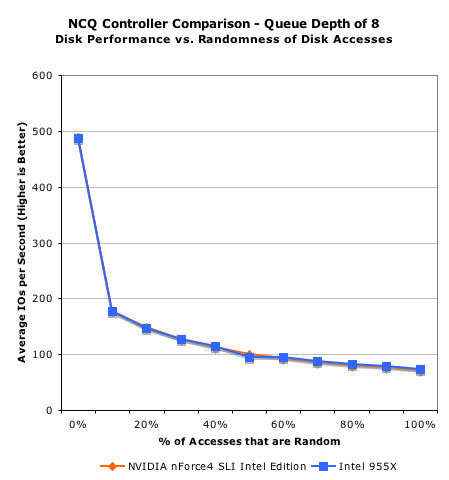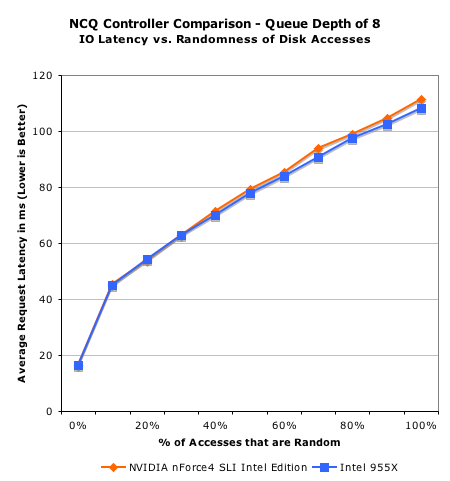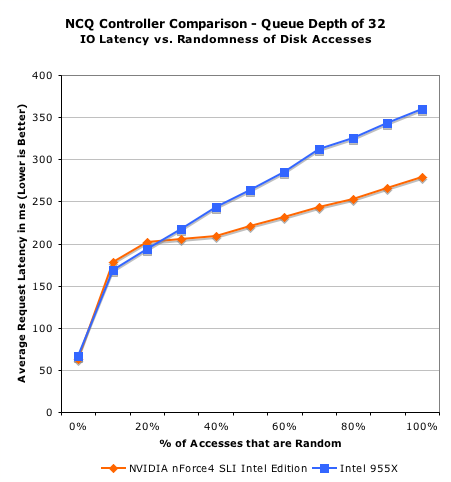Dual Core Intel Platform Shootout - NVIDIA nForce4 vs. Intel 955X
by Anand Lal Shimpi on April 14, 2005 1:01 PM EST- Posted in
- CPUs
SATA Controller Performance
Both NVIDIA and Intel offer support for NCQ in their SATA controllers, and given our recently renewed interest in NCQ performance, we decided to find out if there were any performance differences between the two SATA controllers. However, as we've found in the past, coming up with tests that stress NCQ is quite difficult. Luckily, there is a tool that works perfectly for controlling the type of disk accesses that you want to test: iometer.
An Intel developed tool, iometer allows you to control the size, randomness and frequency, among other things, of disk accesses, and measure performance using data generated according to these specifications. Given that NCQ truly optimizes performance when disk accesses are random in nature, we decided to look at how performance varied according to what percentage of the disk accesses were random. At the same time, we wanted the tests to be modeled on a multitasking desktop system, so we did some investigation by setting up a computer and running through some of our multitasking scenarios on it.
What we found is that on modern day hard drives, the number of outstanding IOs (IO Queue Depth) is rarely above 10 on even a moderately taxed system. Only when you approach extremely heavy multitasking loads (heavier than anything that we've ever tested) do you break into queue depths beyond 32. So, we put together two scenarios, one with a queue depth of 8 and one with a queue depth of 32 - the latter being more of an extreme condition.
In each scenario, we sent the drives a series of 64KB requests, 75% of which were reads, 25% were writes; once again, derived from monitoring our own desktop usage patterns.
We then varied the randomness of disk accesses from 0% (e.g. 100% sequential) up to 100% (0% sequential reads/writes). In theory, the stronger NCQ controllers will show better performance as the percentage of random accesses increases. We reported both Average IOs per Second and average IO response time (how long accesses took to complete on average):

With a queue depth of 8, the two SATA controllers offer virtually identical performance.

Looking at latency, Intel actually offers a very slight performance advantage here - nothing huge, but it's definitely there.
The results get much more interesting as we increase the queue depth to 32:

Here, NVIDIA starts to pull away offering close to a 20% increase in average IOs per second as the access patterns get more random (e.g. as more applications running at the same time start loading down the hard disk).

What's truly impressive, however, is the reduction in average response time - up to a 90ms decrease in response time, thanks to NVIDIA's superior NCQ implementation.
But stepping back into reality, how big of a difference NVIDIA's NCQ implementation makes depends greatly on your usage patterns. Heavy multitaskers that are very IO bound will notice a performance difference, while more casual multitaskers would be hard pressed to find any difference. For example, Intel was actually faster than NVIDIA in our gaming multitasking scenarios from our dual core investigation.










96 Comments
View All Comments
Spajky - Saturday, May 7, 2005 - link
Some comments:Memory Performance:http://www.anandtech.com/cpuchipsets/showdoc.aspx?...
Here should be included also WinRAR´s built_in benchmark & hardware test" in KB/s,
since it can be treated as a real life memory subsystem benchmark (& NOT a Data
Compression Bench! for CPU for example)
WinRAR´s built_in benchmark & hardware test" :
some tests/benchmarks & explanation HOW IT WORKS, here:
http://freeweb.siol.net/jerman55/HP/benchMem.htm
Pontius - Tuesday, April 19, 2005 - link
Didn't realize there was no hardware XOR. Thanks for clearing that up elecrzy.xsilver, RAID 5 is a big deal and is a long way ahead of RAIDs 0 and 1. Most motherboards offer RAIDs 0 and 1, but only high end expensive ones offer onboard RAID 5. Without it, you need a SCSI or SATA RAID card which will run you a couple hundred bucks. To have that on a desktop board is a major deal. But again, since it's done by the CPU without XOR hardware, it's not that big a deal I guess.
elecrzy - Monday, April 18, 2005 - link
sorry i meant #88elecrzy - Monday, April 18, 2005 - link
#89: the chipset doesn't offer its own XOR processor for RAID 5 so it has to rely on the cpu to do the calcs. this basically means you lose alot of performance(high cpu usage) when compared to hardware raid cards.mickyb - Monday, April 18, 2005 - link
RAID 5 and 10 is indeed a big deal for a built in chipset. It is a little outside the scope for a desktop, but cool none the less. I would have to also give a win to nVidia for providing GbE on the chip. I guess Intel would rather people use their GbE separate chip.Zebo - Sunday, April 17, 2005 - link
Zebo - Sunday, April 17, 2005 - link
Intel has a nice chipset, as usual. Nvidia, as usual, clueless about audio desires which would add insignifigant price to chipset at great gains to most consumers. I don't really see the Nvidia recomendation at all unless you NEED, Sli. Intel has more feature, way better audio, the NCQ differences are really none and it's cheaper.xsilver - Sunday, April 17, 2005 - link
#88 -- I think it is old news... I think the older 9xx chipsets offered raid 0,1 for free so offering raid 5 on the newer chip may not be so crash hot??and questar, talking to you is a bit like talking to a brick wall....
a lot of us here already explained that we are arguing about performance NOT volume... what you specify as "qualifications" is due to the sheer volume intel ships.... most people are aware that AMD only has 15% of the market.
If IBM,HP,Dell dont want to "qualify" AMD systems, its their loss, not ours
but no matter how you argue it, AMD has the performance advantage on everything, high end, middle and low end right now and only the laptop pentium M is the performance advantage for intel right now
Pontius - Sunday, April 17, 2005 - link
Am I the only one that noticed that the Intel chipset supports on board RAID 5?!?! That's amazing! No need to buy expensive raid cards anymore. I'm surprised they didn't pay any attention to that in the article.stevty2889 - Saturday, April 16, 2005 - link
My case meets the standards for running prescotts..my 3.2 ES and my 2.8@3.5ghz ran perfectly fine in the same case, the 3.2ES also on the same motherboard, with all the same components, and neither my 2.8 or 3.2ES had the heat issues of my 3.4ghz chip. Not all of them run too hot, but some seem to do so no matter what cooling you throw at them. The 3.4 is still running warmer with water cooling, than my 3.2 ES(which I got from the chip loaner program) is with air.